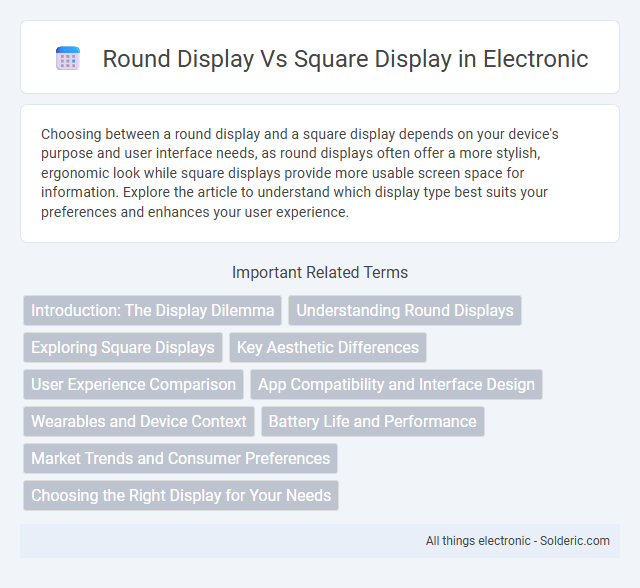Choosing between a round display and a square display depends on your device's purpose and user interface needs, as round displays often offer a more stylish, ergonomic look while square displays provide more usable screen space for information. Explore the article to understand which display type best suits your preferences and enhances your user experience.
Comparison Table
| Feature | Round Display | Square Display |
|---|---|---|
| Shape | Circular | Rectangular or square |
| Screen Usability | Better for watch faces and clocks | Optimized for text and app layouts |
| Resolution | Often lower pixel count due to shape | Higher pixel density, better for detailed content |
| Design Appeal | Classic and elegant look | Modern and practical appearance |
| App Compatibility | May require special interface adaptation | Broad compatibility with standard UI |
| Screen Space | Less effective use of corner space | Maximizes available display area |
| Use Cases | Smartwatches, fitness trackers | Smartphones, tablets, smartwatches |
Introduction: The Display Dilemma
Round displays offer a seamless, aesthetically pleasing design ideal for traditional watch faces and circular interfaces, enhancing user experience with natural hand movements. Square displays maximize screen real estate, providing more information at a glance and better support for text-heavy applications like notifications and data entry. Choosing between round and square displays depends on balancing style preferences with functional requirements for readability and interaction.
Understanding Round Displays
Round displays offer a unique aesthetic and ergonomic advantage by mimicking the natural shape of many traditional watch faces, enhancing visual appeal and user comfort. These displays provide uniform viewing angles and reduce glare, optimizing the readability of circular content such as clock faces, fitness trackers, and notifications. Your choice between round and square displays should consider how each shape impacts user experience, content layout, and device functionality.
Exploring Square Displays
Square displays offer a balanced aspect ratio that enhances readability and user interface design, making them ideal for content-rich applications such as smartwatches and handheld devices. Their uniform dimensions facilitate easy layout optimization and graphical consistency, ensuring clear visualization of icons, text, and data. Compared to round displays, square screens maximize screen real estate, enabling more efficient use of the display area for multitasking and detailed information presentation.
Key Aesthetic Differences
Round displays offer a classic, watch-like appearance that complements traditional and casual styles, while square displays provide a modern, tech-forward look with sharper edges and a more structured design. Round screens typically enhance the visual appeal for analog watch faces and circular graphics, whereas square displays maximize screen real estate for text, notifications, and app interfaces. The choice between round and square displays significantly impacts user perception, device ergonomics, and overall design harmony.
User Experience Comparison
Round displays offer a more natural and ergonomic feel, closely mimicking traditional watch faces, which enhances comfort and aesthetic appeal for your wrist. Square displays maximize screen real estate, providing clearer text, sharper graphics, and easier navigation for apps and notifications. Your choice impacts interaction efficiency and visual experience, with round designs favoring style and square designs prioritizing functionality.
App Compatibility and Interface Design
Round displays often face app compatibility challenges due to their non-rectangular shape, requiring developers to optimize user interfaces specifically for circular screens to ensure full usability. Square displays provide a more standardized, grid-like interface that supports most apps without extensive modifications, facilitating clearer navigation and content alignment. Interface design on round displays emphasizes curved layouts and circular gestures, while square screens prioritize linear and block-based designs for enhanced readability and interaction consistency.
Wearables and Device Context
Round displays in wearables offer a traditional watch-like aesthetic that enhances readability in notifications and fitness tracking, ideal for users seeking a classic look combined with modern functionality. Square displays provide more screen real estate for content, making them better suited for detailed apps, multitasking, and interactive touch controls in smartwatches and fitness bands. Your choice depends on whether you prioritize style and simplicity or maximum information density and usability in your wearable device.
Battery Life and Performance
Round displays often consume less battery due to their smaller screen area and efficient pixel usage, enhancing overall battery life for your wearable device. Square displays tend to deliver better performance with more screen real estate, allowing for clearer visuals and easier interaction with apps. Choosing between the two depends on whether you prioritize longer battery endurance or a more robust, feature-rich user experience.
Market Trends and Consumer Preferences
Market trends indicate a growing preference for round displays in smartwatches, driven by their resemblance to traditional watch faces and enhanced aesthetic appeal. Consumer demand highlights the importance of seamless integration with wearable technology, favoring round displays for fitness tracking and style-conscious users. Square displays maintain traction in professional and utility-focused devices due to better screen real estate for notifications and app interfaces.
Choosing the Right Display for Your Needs
Round displays offer a sleek, modern aesthetic ideal for smartwatches and fitness trackers, enhancing user experience with circular interfaces optimized for notifications and quick interactions. Square displays provide greater screen real estate, supporting detailed content, apps, and easier navigation, suitable for productivity-focused devices and reading-intensive tasks. Selecting between round and square displays depends on prioritizing style and simplicity versus functionality and space for detailed visuals.
Round display vs Square display Infographic

 solderic.com
solderic.com